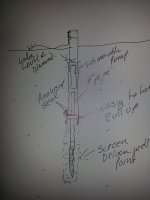mpilihp
New Member
- Messages
- 10
- Reaction score
- 0
- Points
- 1
Hello I am trying to install a well at a camp with the intent that it have the capability for drain back into well as we are in Maine and with frequent power outages I cannot rely on heat tape.
That said the standard drilled well option is out because of price, I got quotes from 3 drillers and the estimate based on existing wells around me is $14-16K, my two neighbors are in the 480-500ft range.
So we tried a dug well with the intent of putting a submersable pump in it and removing the foot valve. The contractor could only go 12ft and we hit clay, and did not produce much water after multiple attempts to pump it dry to see if it would open a vein as he put it.
Looking for other options, the other local contractors that can dig deeper (up to 20ft) both will not do a tiled well but instead use the black plastic culvert 2ft pipe so no one has to climb down into hole. My issue with that is they have not done it with a submersable pump and dont think it can be done.
So two questions -
#1 Is there a pitless adapter that can connect through the thick wall of a plastic culvert wall? (contractors first issue with using a sub pump)
#2 Can a submersable pump be used if it is not secured at the bottom? In the original plan with the 4ft concrete casing the pump was to be secured at the bottom with a PVC pipe and it would be slotted to allow water in.
My second option is I was told by a geologist that drilled the wells for a local bottled water plant up in the area that they only went down 40-60ft range for that plant's wells. He stated that unconfined water is better quality and based on the local aquifer map I have water above the bedrock at my location (which is at aprox 100ft). The issue with this design is well drillers do not buy into drilling for shallow water or are not interested in it as at that depth they do not make much money.
Question here is, if I did convince a driller to do this, how do you know you hit water?
The process the geologist spoke of was putting the casing down till you hit good water, placing a 2 inch pipe down into the casing with a screen on the end, then filling the bottom with sand. Then a Anoluser seal is placed on the 2 inch pipe sealing it to the casing. Then the casing is pulled up to allow the sand to be exposed to the ground. The pump is then installed above the 2in pipe... I just never got the process down of how that is done 40-60 ft down a pipe when your at the top or how to know you hit water....
Anyone hear of doing a well like this? See attached picture of diagram
Thank You
~ Phil
That said the standard drilled well option is out because of price, I got quotes from 3 drillers and the estimate based on existing wells around me is $14-16K, my two neighbors are in the 480-500ft range.
So we tried a dug well with the intent of putting a submersable pump in it and removing the foot valve. The contractor could only go 12ft and we hit clay, and did not produce much water after multiple attempts to pump it dry to see if it would open a vein as he put it.
Looking for other options, the other local contractors that can dig deeper (up to 20ft) both will not do a tiled well but instead use the black plastic culvert 2ft pipe so no one has to climb down into hole. My issue with that is they have not done it with a submersable pump and dont think it can be done.
So two questions -
#1 Is there a pitless adapter that can connect through the thick wall of a plastic culvert wall? (contractors first issue with using a sub pump)
#2 Can a submersable pump be used if it is not secured at the bottom? In the original plan with the 4ft concrete casing the pump was to be secured at the bottom with a PVC pipe and it would be slotted to allow water in.
My second option is I was told by a geologist that drilled the wells for a local bottled water plant up in the area that they only went down 40-60ft range for that plant's wells. He stated that unconfined water is better quality and based on the local aquifer map I have water above the bedrock at my location (which is at aprox 100ft). The issue with this design is well drillers do not buy into drilling for shallow water or are not interested in it as at that depth they do not make much money.
Question here is, if I did convince a driller to do this, how do you know you hit water?
The process the geologist spoke of was putting the casing down till you hit good water, placing a 2 inch pipe down into the casing with a screen on the end, then filling the bottom with sand. Then a Anoluser seal is placed on the 2 inch pipe sealing it to the casing. Then the casing is pulled up to allow the sand to be exposed to the ground. The pump is then installed above the 2in pipe... I just never got the process down of how that is done 40-60 ft down a pipe when your at the top or how to know you hit water....
Anyone hear of doing a well like this? See attached picture of diagram
Thank You
~ Phil

